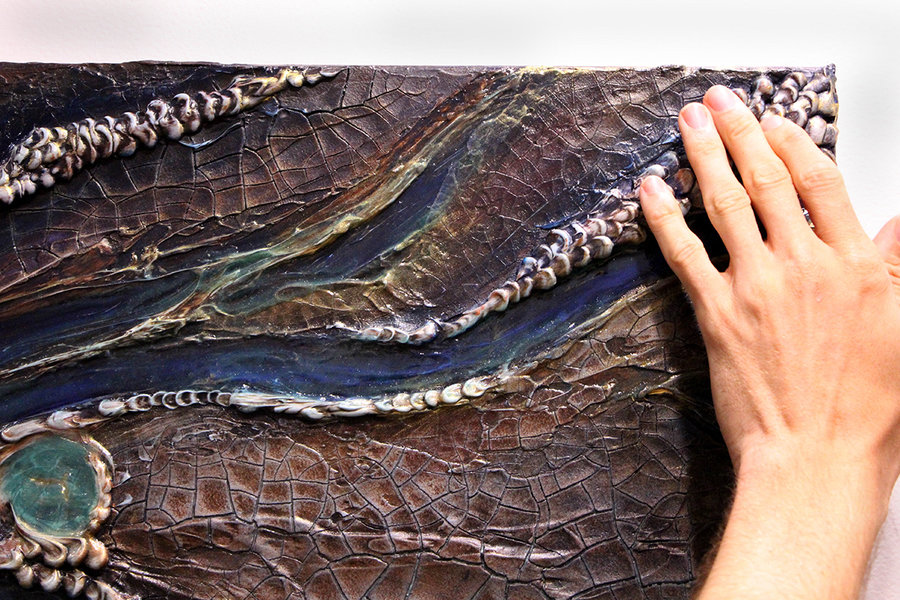In 2015, for example, London’s Tate Britain Museum featured “Sensorium,” which included tastes, sounds, and smells designed to trigger feelings or make certain colors seem more intense. In 2014, the Metropolitan Museum of Art in New York worked with a visiting artist to create “Multisensory Met,” which added sound and smell to small replicas of the museum’s famous sculptures. Recently in Watertown, Massachusetts, the Dorothy and Charles Mosesian Center for the Arts let visitors to get up close and personal by touching and feeling pieces of fine art in “Please Touch the Art.”
While these kinds of exhibits draw all kinds of patrons, museums and artists are increasingly collaborating with members of blind and visually impaired communities to reconsider how art is shared in their spaces.
Exhibits like “Please Touch the Art” and others are not just about touching fine art, observers say. It’s about creating a unique experience for all museum visitors by inviting them to engage all five senses to connect more fully with the artist’s intention, says Georgina Kleege, who teaches creative writing and disability studies at the University of California, Berkeley. While informational encounters are helpful, such as audio tours, more aesthetic experiences are more rewarding – for both blind and sighted art patrons.
“Really, it’s only through touch that … all the qualities of the work are released,” says Professor Kleege, who juried and curated “Please Touch the Art.” Professor Kleege, who is blind, says these haptic encounters are crucial to exhibit engagement.
John Olson, founder of 3D Photoworks in New York, agrees. Mr. Olson develops touchable versions of famous works for museums around the country. The three-dimensional pieces incorporate braille descriptions, textured surfaces, touch-triggered sounds, and sometimes even scent. In his rendition of “George Washington Crossing the Delaware,” an audio component allows visitors to hear water splashing against creaking wood as a narrator recounts historical details about that moment.
“The stimulant of scent can be very powerful,” says Mr. Olson. “When you can smell the water, when you can smell the gunfire, it helps … create that mental picture.”
In Watertown, “Please Touch the Art” grew out of a suggestion from a designer who wanted to rethink how to convey meaning for different audiences, says Aneleise Ruggles, director of exhibitions at the Mosesian Center. To think beyond sight was a challenge taken up enthusiastically by 40 artists who created 52 pieces for “Please Touch the Art.”
“Inherently, visual art doesn’t have another way of engaging on site,” says Ms. Ruggles. “We see [‘Please Touch the Art’ as] much less as an exhibit for blind people. We see it much more as an exhibit that doesn’t exclude people who are blind or have low vision.”
Adding a new level of interaction to art also cultivates shared experiences between patrons by encouraging conversation and connection, she adds, as visitors discuss the sensory details of a piece.
“That people of all abilities and all interests and all perspectives are able to come and engage with the same work of art is really important to us,” says Ms. Ruggles.
During the final weeks of “Please Touch the Art,” one group of patrons with visual impairments appeared particularly focused. At first, tentative hands passed over the cool, vibrant, sharp-edged tiles that formed a wide-eyed fish in Jean Cummiskey’s “Go Fish.”
One man was drawn to the textured blue canvas of Claudia Ravaschiere and Michael Moss’s “Whirl.” As he ran his hands over the canvas, soft synthesizer music followed his movements, creating a unique composition.
By the end of the tour, the visitors had lost all shyness about touching the pieces and they encouraged each other and wrapped themselves up in hanging felt and stuffed velvet.
Exhibits that invite patrons to interact with artwork have the potential to change perceptions of what is considered fine art, but it won’t happen overnight, says Professor Kleege. “Art audiences as well as art critics and scholars will need to come up with new ways of understanding what art is and what it can do,” as well as “a way to talk about what artists are doing when they produce work meant to be touched.”
Source: Please touch the fine art: Multisensory exhibits on the rise – CSMonitor.com













